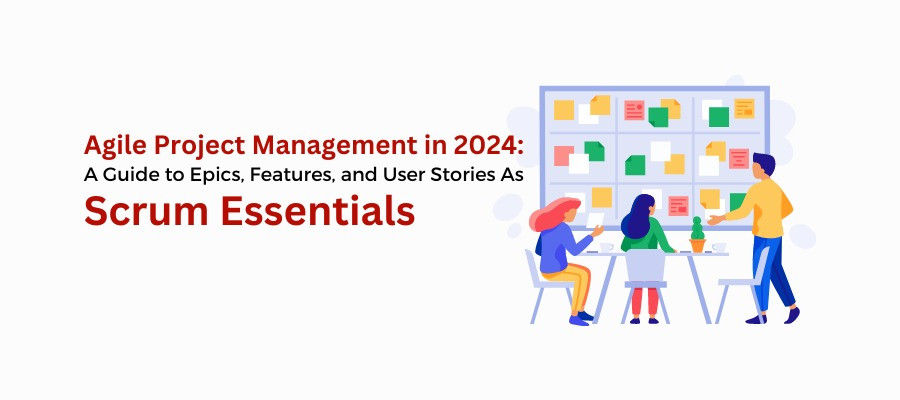Agile Project Management in 2024: A Guide to Epics, Features, and User Stories As Scrum Essentials

Have you ever wondered how Agile methodologies have transformed project management in recent years? Scrum will emerge as the primary Agile methodology as the best framework for Agile project managers in 2024.
The Scrum essentials like Epics, Features, and User Stories are shaping the project management activities across Scrum Teams. So, today's Product Owners and Agile Leaders must learn and use these components to streamline their project management responsibilities.
So, let's explore the Scrum essentials: pictures, features, and user stories!
What Are Epics in Agile?
An Epic is a high-level work management tool comprising multiple User Stories. Epics serve as large bodies of work that can be broken down into smaller and manageable tasks. Think of them as overarching initiatives that encapsulate broader organizational objectives. As highlighted by Scrum.org, Epics act as containers for User Stories that offer a high-level view of project requirements.
The Basic Structure of Epics:
Epics typically encompass multiple User Stories, forming a cohesive narrative that aligns with the Product Goal. Certified Scrum Product Owners collaborate with Scrum Teams and stakeholders to define the Epics that add value to the business and associated products.
Epics are like large folders containing multiple sub-folders. The sub-folders are User Stories and Product Backlog Items (PBIs) representing smaller pieces of work based on the Epic. The structural hierarchy of Epics follows the Product Roadmap to drive the Scrum Team towards the end Product Goal.
Applying The Epic Structure For Continuous Value Delivery:
Agile Practitioners employ various tools and techniques to maximize the benefits of Epics. Agile teams break down the Epics into User Stories and PBIs to complete them individually. Workshops and Agile Training sessions facilitate Epics' creation that aligns with the ultimate Product Vision. Furthermore, Agile Coaches continuously refine the Epics to ensure they meet the Definition of Ready before integration into the Product Backlog.
This way, the Epics ensure continuous value delivery based on the Sprint Planning and Product Backlog Refinement.
What is a Feature?
While Epics provides a macro perspective, Features focuses only on specific product functionalities or components. According to Roland Wanner, Features translate high-level requirements into actionable tasks. Agile Developers consider the Features as the main branch and link it with all associated User Stories and Tasks to complete in one Sprint.
Key Elements To Define A Feature:
Features encapsulate distinct product functionalities by mapping different User Stories in its collection. Features often align the user needs or system capabilities with the Sprint Goal. Agile Product Owners collaborate with the Developers and the Scrum Team to prioritize Features in the Product Backlog. Thus, teams focus on their Sprint Planning, and the Scrum Master keeps refining the Features based on the completion of User Stories.
How is A Feature Different Than an Epic?
While Epics focuses on overarching goals, Features focuses on specific functionalities or user requirements. Certified Scrum Product Owners (CSPO) collaborate to delineate Features. They ensure that the Features resonate with both technical and business stakeholders. This distinction fosters granularity and enables Agile Developers to prioritize tasks effectively.
What is a User Story?
A User Story is a concise, user-centric narrative encapsulating specific product feature requirements or functionalities. As emphasized by Scrum Alliance, User Stories prioritize customer value and serve as the building blocks for Epics and Features.
Key Elements To Define A User Story:
User Stories comprise three essential components: the user, the action, and the benefit. Agile Teams collaborate to craft User Stories and write them with clarity and relevance. When you create a User Story, you first write the summary. Next, you prepare the description and Acceptance Criteria for Agile Developers to follow.
The Product Owner also refines the User Stories and makes them active from the Features list based on the objectives for upcoming Sprints. The Developers then work on the active User Stories for that particular Sprint.
How Are User Stories Related To Epics & Features?
User Stories exist within the framework of Epics and Features. They provide actionable insights into specific product functionalities or user requirements. Scrum Teams and Product Owners collaborate to prioritize User Stories. Developers create tasks under the User Stories to align their work progress with the Sprint Goal. This symbiotic relationship fosters cohesion among Agile Teams to deliver value through achieving the ultimate Product Goal.
Why Are Epics, Features, And User Stories Necessary in Agile Scrum?
Epics, Features, and User Stories - These are the Scrum Essentials, though not defined in the Scrum Framework to make your Agile Project successful. They follow the Product Vision and align the Developers with the Product Roadmap. They help the Scrum Teams in Sprint Planning and Product backlog Refinement. For Agile Leaders, Scrum Masters, and Product Owners, these three Agile elements are the must-have to facilitate smooth product management.
Summing Up:
As 2024 arrives, Scrum stands out as a transformative force with essentials like Epics, Features, and User Stories. You can unlock unparalleled efficiency and innovation by embracing these three Scrum essentials. Discover every bit and piece of Agile Scrum as you embrace Agile and harness Scrum in 2024!
Reference:
https://resources.scrumalliance.org/Article/epic-agile
https://www.linkedin.com/pulse/demystifying-epics-features-user-stories-neeraj-bachani/



